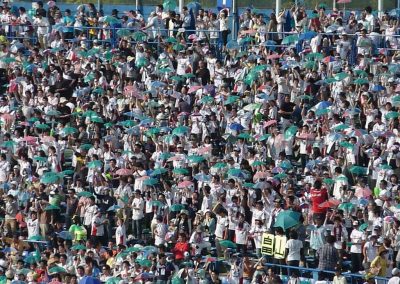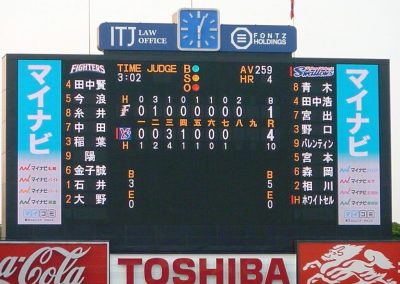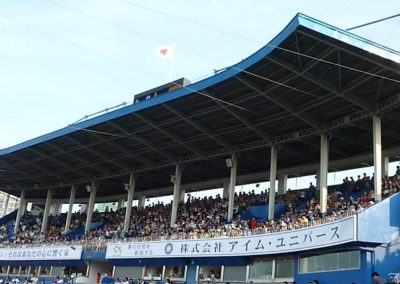Meiji Jingu Stadium - Tokyo Yakult Swallows
- Sean MacDonald
- Aug 4, 2013
- 7 min read
Updated: Mar 11, 2023
Photos by Sean MacDonald Stadium Journey
Stadium Info FANFARE Score: 3.43
Meiji Jingu Stadium Kasumigaoka-cho 13 Shinjuku-ku, Tokyo, 160-0013 Japan
Year Opened: 1926 Capacity: 37,933
The Meiji Jingu Shrine (to Baseball)
Meiji Jingu Stadium is the second oldest of the Japanese ballparks, having been built in 1926, just two years after Koshien. It’s gone through several renovations since then but is still one of the best stadium experiences you can have in Japan.It is located in the Aoyama district of Central Tokyo and is relatively close to the Meiji Jingu Shrine, the organization that actually owns the stadium. The home team is the Tokyo Yakult Swallows, who play in the Central League, and are owned by Yakult, a company most famous for their yogurt-like drinks. Jingu also hosts countless college and high school games during the year and is one of the most widely-recognized ballparks in the country.
Food & Beverage 3
There are a number of small concessions on the very narrow concourse, offering typical Japanese snacks but nothing out of the ordinary. I would recommend the spicy chicken stick at 200 yen, and if you want to try something slightly offbeat, go for the takoyaki, which are small bits of octopus stuffed in batter and then fried. If you are really hungry, try a bento box, which are good value at between 600-850 yen. Drinks can be bought in your seat from one of the dozens of vendors who are carting kegs of beer on their back or on a tray in front.
Rather than try the ballpark food though, most fans pick up their eats on the way to the stadium. As you walk up the main street from Gaienmae subway station, you will be presented with several small tables selling sandwiches, noodles, gyoza, and other snacks. Beer is also much cheaper here, but you must pour it into a cup when you enter the stadium (although they don’t actually check your belongings). I highly recommend this option as you get more variety at a better price. The only problem is that it can get quite crowded and you might have difficulty backtracking as the masses walk toward the stadium.
If you are looking for some post-game fun, stop in at the Hub Pub just three minutes away, again on this street. It’s one of several branches of a faux-English establishment that serves drinks and pub food at reasonable prices. If you want to enjoy a more traditional Japanese experience, try Toan right next door. It’s an izakaya serving tofu and chicken dishes and is really quite good. However, it is small and fills up quickly, so you might want to make a dinner reservation as you walk to a weekend afternoon game.
Atmosphere 4
Jingu is often quiet, particularly during night games which draw fewer fans, but I saw a Saturday afternoon affair with nearly 27,000 filling the ballpark. It was a perfect afternoon for baseball, hot but not humid, the outfield stands filled with cheering supporters, colorful beer vendors parading up and down the aisles, the bright green artificial turf, truly a quintessential Japanese baseball experience.
Unfortunately, though, there was one element that the Swallows recently introduced that I found highly bothersome: the stadium DJ. This guy is a glorified PA announcer that spends his time shouting into a mike from 30 minutes before the game right to the end, making every inning break a cacophonic catastrophe.
His presence destroys the atmosphere for me, but as he only exists for Swallows games, I won’t dock more than a point.
Neighborhood 3
The stadium is part of a larger sports complex that includes National Stadium, a soccer and track facility that hosted the 1964 Summer Olympics, Chichibunomiya Rugby Stadium, a couple of gymnasiums, and even a smaller baseball field that doubles as a golf range. It is a very central location, but the large number of other venues make it somewhat weak as a true neighborhood. There are restaurants and shops along Aoyama-dori, just south of the ballpark, but little worth noting from a tourist point of view, at least in the immediate vicinity.
Once you get more than a mile away though, you can see the bright lights of Shibuya, or the nightclubs of Roppongi, or the two faces of Shinjuku, all within a short walk or subway ride.
Fans 5
Yakult fans are among the best, and have the most famous celebration in the country. Whenever the Swallows score, the fans (not just those in the outfield, but almost everybody on the first base side) curse the opponents, break out tiny plastic umbrellas and sing “Tokyo Ondo,” a famous traditional tune. It is a great sight and sound and worth checking out on YouTube. Nothing is more disappointing than visiting Jingu and seeing the Swallows shutout.
The game I saw had loud cheering in left field too, with the visiting Nippon Ham Fighter fans providing the noise during the top half of each inning.
I also noticed that fans tended to stay seated here during the action, something that I appreciate. Overall, a great fan experience.
Access 3
The closest station to Jingu is Gaienmae on the Ginza line, the oldest subway in Tokyo. From here, it’s about a 5-minute walk to the stadium, with the sidewalk quite narrow in some places. This is where you would buy your food or stop at the pub as mentioned above. You’ll also walk by the rugby ground. After the game, the crowd spills out onto the street as you return to the station. The Ginza line train can be quite crowded at this time, so I prefer to walk a few extra blocks to Aoyama Itchome station, which has some other lines that are far less busy.
There are several other stations within walking distance but the Gaienmae approach is the best as that is where you can stock up on food and beer.
Once inside the stadium, you will find the only concourse to be very narrow. Hey, the place is 85 years old, so no complaining! Even with the tight quarters, I never have had trouble navigating, because most fans spend the game in their seats, since they bring their food in with them.
You will need to enter by the gate printed on your ticket, but once inside, you can roam about the seating bowl as long as you haven’t found yourself in the unreserved seats. Those areas are separate and you can’t move back and forth.
The facilities here are very limited, and I noticed lines for both men and women throughout the game.
If you need to take a break, try to beat the post-inning rush.
Return on Investment 4
Tickets at Tokyo Yakult Swallows games are reasonably priced, with the most expensive only 4,500 yen ($56). The single seating bowl is quite flat for the first 13 rows, then slightly steeper for the next 12 rows, before the final 20 rows rise quite quickly. There is a walkway in front of row 14, and the main concourse is in front of row 26, so avoid those rows if you hate having people walking in front of you during the game.
I recommend the 2,600 yen B seats that are in the top few rows – the reason being that there is a fence that stretches the whole way down the line, right to the foul pole. Unlike protective netting, this fence really harms the sightlines and is the worst thing about Jingu. There are big bars between each section of fence that can destroy your pictures if you are unlucky enough to have a seat there. Only in the top 6 rows or so can you have an unobstructed view of the action.
As you move down the line, the seats don’t face home so you will be craning your neck to watch the action. The low seats beyond the bases are some of the worst in Japan so try to avoid those. The seats are numbered from 0 directly behind the plate and increase in both directions down the lines. I was in seat 154 well down the first base line so you can use that as a guide.
For those who wish to sit with the cheering sections, the outfield is a separate area and the cheapest place to sit. Sections A to L comprise the right field side, while M to X takes up left field.
There is also one covered section which is called the second floor. On a hot summer’s day, this is the only reprieve you will have from the sun, and it fills up quickly. I enjoy the view from here as the field stretches out beneath you and the city beckons beyond.
What I really like at Jingu is that you are afforded the freedom to move around in the main bowl. I never had anybody check my ticket and when it got too hot in my assigned seat, I zoomed over to the cooler side of the ballpark and sat in an open seat without receiving a second glance. Very non-Japanese and makes up for all the poor seating options and hence the ROI is a healthy 4 out of 5.
Extras 4
Being such an old stadium, there isn’t much else here besides the ballpark. The scoreboard used to have the batting average and home runs for each player in the lineup but this has been replaced by advertising, which really detracts from its appearance. The relatively new video screen is nice, but nothing extraordinary.
On the indoor concourse directly behind home plate, you’ll find a plaque commemorating the stadium along with some signed plaques from an all-star game in 1997. This comes with a roster with pictures of all the players, including a baby-faced Ichiro Suzuki and is worth looking for.
The clubhouse is outside the ballpark so the Swallows players have to walk, in uniform, past hordes of fans to get into the stadium. This gives you a chance to take some good shots if you are so inclined, but the fans are respectful and autographs are not sought out here.
The actual structure is similar to a Roman coliseum on the outside, with arched entryways that make for a compelling first impression. Sadly, the gates are now strewn with plastic fencing and garish signs that keep fans in order while entering, but ruin the effect of the original architecture.
The worst thing about Jingu is the aforementioned fence that stretches from home plate all the way down to the foul pole. It’s ugly and pointless. At the game I attended, a young man sitting in the 10th row was dinged by a line drive which he probably couldn’t see in time due to the fence. Even worse, it took the game staff a while to check on him (he had to leave the game with a bruise).
Despite all this negativity, Jingu will always have a special place in my heart, as it was here that I saw the Swallows win the Japanese championship in my first summer in the country, back in 1997.
Final Thoughts
Meiji Jingu Stadium is a must-see for any baseball fan visiting Tokyo. When the weather is nice and the crowd is hopping, a better baseball experience is difficult to find. And even if it’s not raining, don’t forget to bring your umbrella.










Comentários